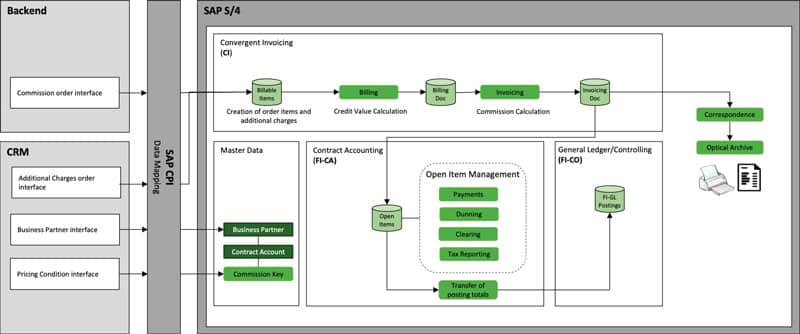Invoice too big - what now?


A full 791 million purchase orders to be billed in the third quarter of last year alone are a challenge for any billing system. With SAP Billing and Revenue Innovation Management, BRIM, the platform operator has found a billing solution that will also grow with the future challenges in the digital market.
The former start-up market for delivery services is highly competitive and has now become cutthroat competition. To win one of the local markets, a delivery company has to deliver high quality coupled with high performance, knows Stefan Heyens, Director Finance Systems at Delivery Hero. This is not only about delivering products to end customers quickly, but also interacting with partners such as restaurants and supply chains in a timely and reliable manner. "Especially at the beginning of the global corona pandemic, we found that our previous billing solution could only cope with the sometimes exponential growth in delivery orders with limitations"says Stefan Heyens.

B2B2C success for all
Although the end consumer is at the end of the supply chain, the platform business is a B2B business between Delivery Hero as the platform operator and the connected restaurants and food chains. Sometimes couriers are added, the so-called riders, as long as they are billed via the platform. There are different contracts with the food chains with special commission scales and other fees that can vary. A permanent challenge here is that consumption-dependent items must be generated for commission billing based on the customer orders that run via the platform, i.e., how many burgers or pizzas were actually ordered via McDonald's, Pizza Hut and the like, and by whom they were delivered. The items from the customer orders are translated into what are known as "billable items" in order to be able to bill them at all with the help of software.
Jasmina Cejan, Principal Consultant at GTW Management Consulting GmbH in Vienna, specifies: "At Delivery Hero, on the one hand, we have an extremely large number of invoices in bulk current accounts, and on the other hand, we have exorbitantly large collective invoices from the Big Five that contain hundreds of thousands or even millions of line items." So when Pizza Hut, McDonald's or Burger King in one of the million metropolises like Singapore use the ordering platform, several million orders quickly accumulate in a month; every pizza, every burger, voucher, discount, delivery fee per order is recorded and added to the collective invoice. "That's exactly where the sticking point is, because our previous billing solution couldn't handle that anymore. We had to aggregate this entire volume in some way in order to be able to bill it at all."Stefan Heyens recalls the initial situation. Even if the collective invoices still went through as PDFs via e-mail, such volumes of data could not be processed.
Until then, the delivery service had mainly used SAP SD, and in some local markets also a solution developed in-house for them. "We found that our locally adapted tools could no longer cope with the increased order volume and the SD solution was also gradually reaching its limits. The billing run time was over ten hours in some cases."says Stefan Heyens. Initially, he and his team tried to optimize the invoice run by parallelizing jobs and other tricks.
But the runtimes hardly became shorter. At some point, the error message appeared: Invoice too big. "We created a solution for ourselves there, with which we could split such a collective invoice at least halfway and process it automatically." However, this was by no means satisfactory. "This is exactly where we come in with BRIM and combine these two important requirements of the digital platform business: the mass current account via SAP FICA supplemented by Convergent Invoicing"explains Jasmina Cejan.

Jasmina Cejan, Principal Consultant, GTW
BRIM wins billing PoC
When Delivery Hero was looking for an alternative billing solution in the SAP environment in 2019, they soon came across SAP BRIM. "After various workshops, we came to the decision in 2020 to set up a proof of concept (PoC) in SAP BRIM"explains Stefan Heyens the first steps. "We saw BRIM as an ideal solution to optimize the performance of our billing process in the long term. Due to Delivery Hero's strong growth, we wanted a solution that was almost unlimited in terms of the number of orders per invoice, which would allow us to continue billing our orders in a stable and timely manner in the future."
During the PoC, the initial focus was on the Convergent Invoicing and Invoicing part. It was particularly important to ensure that the billing solution could also handle invoices containing more than one million orders. Another important factor was the duration of the billing runs: the goal was to reduce these by at least 50 percent. In the middle of the implementation, the PoC then became a "live project", which is why the effort had skyrocketed a bit. Parallel operation was ensured so that a direct comparison between CI and SD could take place.
"We couldn't afford to make a mistake, the solution had to be easy to switch on and off - switch on/off - in case management decided against it in the end"says Stefan Heyens. And the restaurants should also be as unaware as possible of the changeover, which is why PDFs and Excel sheets, for example, were left in the old layout and interface adjustments were limited to the most necessary. There were no changes in the previous system; existing interfaces were merely expanded to include Convergent Invoicing.
In BRIM, all details of an order are stored as billable items, i.e. how much was food, how much discount, how much delivery charge. This information can be used for billing the most diverse commission models, regardless of whether billing is done on a daily, weekly or monthly basis. "We can calculate pretty much anything, at any point in time, multiple times if needed. This also allows us to map models where the commission is settled weekly, for example, but calculated again retroactively at the end of the month, and then only the difference is posted."explains Jasmina Cejan the logic behind the billable items. Standard interfaces ensure the necessary data transfer with the payment service providers. Whether a restaurant transmits this as an e-mail, SMS, or whatever, is ultimately irrelevant for the billing solution.
One reason for introducing the billing solution was and is its flexibility with regard to pricing. Delivery Hero offers partners various commission models, depending on the market. "To implement new commission models in BRIM, in most cases it is sufficient to adjust the configuration, which in turn eliminates the need for complex coding changes"Finance Director Stefan Heyens is visibly enthusiastic. Another enormous advantage is that it allows all possible billing cases to be tested on the market. The sales team is quite creative when it comes to new commission models for the delivery service.

"That's when it's good to be able to test out all the ideas in BRIM early on, including what might be coming up next year." If the tests go well, live scaling can be implemented directly. In Singapore, for example, daily billing was implemented to get the data volumes under control. In order to test staggered price conditions and go live with them, Delivery Hero was quick to develop its own in SAP SD.
"However, we want to look at the sales of a restaurant over an entire accounting period, for example, in order to determine graduated prices based on this. We don't have this option in SD, which always focuses directly on the orders for commission calculation. In this context, however, we are interested in the entire accounting period and this works out of the box in BRIM," Stefan Heyens was able to see for himself. And Jasmina Cejan adds: "In SAP BRIM, we have already implemented quite a few alternative billing models in the standard, so that companies can also test new digital business cases at any time.
Currently, a global template is being worked on to avoid having to maintain a separate solution in each country. "Because of our start-up culture, we naturally try to implement the BRIM solution as quickly as possible in a rapidly growing market, and only harmonize something afterwards"explains Stefan Heyens the procedure so far. Now his plan is to move more and more in the direction of a standard solution. Only the legal requirements of the market may vary, otherwise a global template should be used if possible. "If we use the example of one country to show that the billing goes through performantly within an hour, then no one wants to change anything there either. They feel secure with the data we provide in the billable items and understand the need for a global template."Jasmina Cejan is convinced.
Time saving with BRIM
The goal had been to reduce the runtime at the large food chains by 50 percent. "We managed to do that, and we even got better, more in the direction of 80 percent optimized," Stefan Heyens is pleased to report, "often less than an hour." All other invoice runs could be reduced to 15 to 30 minutes with SAP BRIM.
The fact that the team in Singapore reported the positive effect of the time savings relatively soon after the go-live meant that there was also a great desire to implement something like this in other countries. And the management was finally convinced of the result and the real added value, so that BRIM could be rolled out in Thailand, the Philippines and Malaysia. The next projects are also already firmly in sight: The rollout in Bangladesh is currently underway, and Pakistan and other markets where order volumes are increasing are to follow before the end of the year.
Since in Pakistan often only the cell phone number of a restaurant is known, but no e-mail address, an additional SMS invoice dispatch in BRIM is to be implemented there. In addition, an increasing order volume can be seen in Taiwan, where apartments without kitchens are rented due to the high rental prices, so that it is now common practice to order food online.
Last but not least, Delivery Hero plans to implement a corporate billing process in the BRIM solution. This will enable companies to bill all of their employees' food orders via the delivery service platform on a collective invoice. In addition, it will also be possible in future to include so-called "additional charges" in an invoice run, i.e. all fees incurred that do not fall under the usual commission business. Examples include certain product placements for restaurants or the provision of an Internet presence. And the conclusion of Stefan Heyens: "We are, of course, relying on GTW's highly professional boutique consulting services for our future projects as well."He also has an eye on the further automation of processes.






